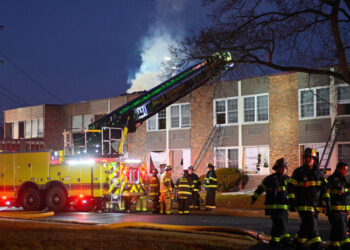At least 55 people have died and the official death toll may rise as firefighters in Hong Kong continue to fight one of the city’s deadliest ever blazes that broke out over 24 hours ago and continues to devastate a multi-block housing estate.
[time-brightcove not-tgx=”true”]
The fire in Wang Fuk Court, an eight-block complex built in the 1980s in the northeastern district of Tai Po, began on Wednesday afternoon and spread to seven of the estate’s buildings. By nightfall, the city upgraded the fire to a level 5 alarm—the highest severity on the city’s scale. It continued to burn on Thursday, though by 3 p.m. local time (2 a.m. ET), the fires in four of the blocks had been extinguished and the other three were “under control.”
Authorities are still investigating the fire’s cause, but their preliminary findings flagged the “unusual” speed at which it spread was potentially abetted by flammable materials. Hong Kong Security Secretary Chris Tang, in a press conference early Thursday, said that officials are looking into the “protective netting and films on the buildings’ exterior walls, as well as some waterproof tarpaulins and plastic sheeting” that may have “spread the fire much more violently and rapidly than some compliant materials,” as well as “expanded polystyrene sheets pasted on windows.”
The city’s historical use of bamboo scaffolding, which was in use at the Wang Fuk Court blocks, which has been under renovation since 2024, also came under renewed scrutiny. Hong Kong’s Fire Services Department saw upon arrival at the estate that the scaffolding and the green mesh on the buildings had caught fire, according to a government statement. Videos circulating on social media also show that the fire had burned through the mesh, leaving the bamboo scaffolding behind.
Early Thursday, Hong Kong police announced the arrest of three individuals from a construction engineering firm on suspicion of manslaughter, after officers found they had installed the polystyrene sheets. A spokesperson told local media that police “have reason to believe that the company’s responsible persons were grossly negligent, which led to the incident and caused the fire to spread rapidly.”
The Wang Fuk Court fire’s death toll is still expected to rise, as dozens have been sent to the hospital and hundreds more residents remain unaccounted for, but it has already surpassed the casualty count in the 1996 Garley Building fire that left 41 dead and 81 injured.
But Hong Kong has been the site of many significant fires in the past, which, like the Wang Fuk Court incident, have had various specific causes, but have also often shared some factors that contributed to their deadliness.
Density
Hong Kong, a semi-autonomous Special Administrative Region of China, is one of the most densely populated areas in the world, with 6,900 residents per sq km. Many buildings are built close to each other, especially in Hong Kong Island and neighboring Kowloon, making it easy for fires to spread.
However, the city also owes much of its high population density to the prevalence of subdivided flats—small cut rooms, sometimes resembling animal cages—where residents can cram and reside in for a fraction of the cost of a standard Hong Kong flat.
In April 2024, a fire involving a 60-year-old tenement block in Yau Ma Tei in the Kowloon area left five people dead and dozens injured. In an op-ed at the time about the risks associated with these homes, the South China Morning Post explained that, while a cigarette may have caused the fire, firefighters said subdivided units and “structural alterations” in the building complicated rescue efforts.
Thirteen years earlier, a fire in Mong Kok, also in the Kowloon area, left nine dead, 34 injured, and more than a hundred people homeless. Authorities then pointed out that the danger was exacerbated by the subdivided flats cutting off points of access for the building.
Economic struggle
Hong Kong is also among the most expensive places to live globally, and both individuals and businesses in the Chinese enclave often seek cost-cutting shortcuts that, in the case of fires, have proven immensely costly in the end.
Subdivided flats are a response to an expensive housing market, and many residents have foregone safety requirements for the sake of having a place to live.
Fireproofing is also expensive. In the 2024 Yau Ma Tei fire, the building’s owners reportedly encountered difficulties in raising funds to comply with fire safety guidelines, with a district councillor noting that “the increasingly high cost of upgrading fire prevention facilities and equipment, especially in the bidding process, had not helped,” according to SCMP.
Bamboo scaffolding, which has been linked to the latest conflagration’s devastation, is also known as a cheap alternative for construction businesses despite the city’s Development Bureau pushing to “drive a wider adoption of metal scaffolds in public building works progressively,” with a bureau official citing bamboo’s “intrinsic weaknesses such as variation in mechanical properties, deterioration over time and high combustibility, etc, giving rise to safety concerns.”
Lax enforcement
Politicians in the city have flagged that many of the city’s buildings are rapidly aging and in need of better fireproofing.
But previous fires have shown that compliance with government orders has been poor. In the 2024 Yau Ma Tei fire, the city’s Buildings Department already issued fire safety orders to the owners of the block in question in 2008—including calling for them to replace fire doors and outfit the building with more fire-resistant material. But SCMP reported that despite the department’s follow-up, the order had not been followed.
Since that fire, legislators passed a law enabling the government to carry out fire safety improvement works and target building owners who fail to comply. But a city lawmaker raised earlier this year that violations persist, including public passageways being blocked by miscellaneous items and smoke-stop doors being left open in composite buildings and factory buildings.
Latest government data show that more than 8,600 fire hazard abatement notices have been issued in Hong Kong as of January, following inspections of old, high-risk buildings. More than 300 of these notices involved prosecutions or convictions.
The post Why Hong Kong’s Latest Fire Is So Deadly—and It’s Not the First appeared first on TIME.




